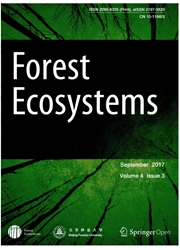

 中文摘要:
中文摘要:
以便在木头的深水望远镜上澄清抽取和压缩的效果,赤木质取样与或没有抽取的中国冷杉木(Cunninghamia lanceolata 钩) 放射状地或无关地在房间温度在浸透水的状况下面被压缩。温暖的水和 1% 氢氧化钠被用作抽取的不同解决方案。压缩样品的水吸收容量和潮湿吸附等温线然后被测试。内部木头的分数维的尺寸出现(D fs ) 被 FHH 基于吸附等温线计算方程。结果证明在两个都压缩的组,样品的深水望远镜由当温暖的水提取的样品的改变了很少时,极大地改进的氢氧化钠答案提取了,与浸透水的样品的相比。集合的恢复和在木头内的深水望远镜的环境的变化是为在与温暖的水和氢氧化钠答案提取的浸透水的样品和样品之中的水吸收的差别的主要原因。氢氧化钠答案显著地提取的样品的胀大的率增加了。而且,在无关地压缩的样品的正切的方向的胀大的率在放射状地压缩的光线的方向显然比那高。D 温暖的水和氢氧化钠答案提取的森林的 fs 价值在一个无关地压缩的组在一个放射状地压缩的组并且在 0.013 和 0.013 在 0.002 和 0.007 减少了,与那些相比浸透水的。因此,结论能被做在这研究使用的抽取和压缩处理没在内部木头上有明显的效果表面。
 英文摘要:
英文摘要:
In order to clarify the effects of extraction and compression on the hydroscopicity of wood, Chinese fir (Cunninghamia lanceolata Hook.) heartwood samples with or without extraction were radially or tangentially compressed under water-saturated condition at room temperature. Warm water and 1% sodium hydroxide were used as different solutions for extraction. Water absorption capacity and moisture adsorption isotherms of the compressed samples were then tested. The fractal dimension of internal wood surfaces (Dfs) was calculated based on adsorption isotherms by FHH equation. Results showed that in both compressed groups, the hydroscopicity of samples extracted by sodium hydroxide solution improved greatly, while that of samples extracted by warm water changed little, compared with that of water-saturated samples. Recovery of set and the change of hydroscopic environment inside wood were main reasons for the difference of water absorption among water-saturated samples and samples extracted with warm water and sodium hydroxide solution. The swelling rate of samples extracted by sodium hydroxide solution significantly increased. Moreover, the swelling rate in the tangential direction of tangentially compressed samples was obviously higher than that in radial direction of radially compressed ones. Dfs values of woods extracted by warm water and sodium hydroxide solution decreased by 0.002 and 0.007 in a radially compressed group and by 0.013 and 0.013 in a tangentially compressed group, compared to those of water-saturated one. Therefore, the conclusion can be made that the extraction and compression treatments used in this study have no obvious effects on internal wood surface.
 同期刊论文项目
同期刊论文项目
 同项目期刊论文
同项目期刊论文
 期刊信息
期刊信息
